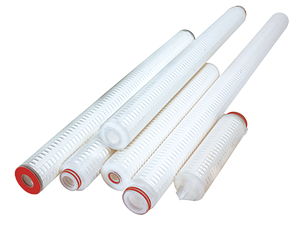Why is Pre-Filtration necessary for RO(Reverse Osmosis) systems? Do I need RO prefilters?
Reverse osmosis is a water filtration method that uses semi-permeable membranes to remove unwanted contaminates, such as molecules, particles, and ions from water. Pressure is used to force water through the RO membranes, which have precise pore sizes. RO membranes remove a majority of contaminants, giving high-purity water. But they need to be protected from larger contaminants using RO prefilters.
Due to RO membranes precise pore sizes if incoming water has contaminants typically greater than 5 microns it can lead to the formation of biofilm and cause damage to expensive RO membranes reducing the effectiveness and performance of the RO system, costing you time and money. Pre-filtration is a required step by the U.S. Food and Drug Administration (FDA) in the food and beverage industry and in pharmaceutical production but should be considered for all RO systems. RO membranes are expensive typically costing anywhere from $500 to upwards of $2,000 per membrane, without proper prefiltration changeouts on RO membranes can be doubled. RO prefilters may seem less crucial compared to the RO membranes, but they are vital to the water filtration process.
Reverse Osmosis Pre-Filter Recommendations
As a general rule and industry standard a 5-micron rating pre-filter is recommended. The micron rating on a filter determines the size of particles that will pass through the filter. The smaller the micron rating the greater the particle retention, however, there is a trade-off, the flow capability drops as the micron rating gets smaller especially if the water has a lot of contaminants. 5-micron meltblown cartridge filters have historically been used as prefilters, but pleated cartridge filters are a higher efficiency and higher performance alternative. The pleated cartridge filter structure allows for greater loading capacity and more consistent particle retention. This is important because small quantities of microorganisms can grow quickly and cause RO systems to be overrun with biofilm in weeks.
Global Filter recommends using a combination of pre-filters to prevent premature clogging while having sufficient flow capabilities, this is dependent on the quality of incoming water. If the incoming water has a large amount of sediment, it is best to install a 20-micron-rated filter upstream of 5-micron and 1-micron filters. If sediment is minimal then 5-micron and 1-micron filters are efficient. It is best to use absolute-rated filters at these steps as they have higher amounts of retention efficiency. Global Filter recommends using pleated polypropylene filters for prefilters. Global Filter has multiple configurations and sizes available as well (see below).
If a reverse osmosis membrane is sufficiently protected it should last roughly 2 years before needing replaced. If it needs replacements before 2 years, it typically has insufficient protection, costing you time and money.
RO Prefilter Cost Savings
Melblown or pleated filters can work in this step, but it is important to consider the associated costs with each. Pleated filters have a higher purchase price than meltblown filters due to the design and manufacturing behind them. Meltblown filters last approximately 1-2 weeks in the prefiltration steps depending on water quality. Plants schedule weekly or biweekly maintenance change-outs based on historical filter performance. Whilst pleated filter cartridges can typically last about twice as long in both of those steps. Monitoring the pressure drop on both types of filters will indicate the need to replace them.
It is important to consider overall costs and not just the cost of the filter you are purchasing, some key factors to consider are:
- Proper prefiltration protection can significantly reduce the impact on the reverse osmosis system doubling its life, saving time and money
- Fewer filter change-outs on prefilters and RO Membranes means labor and maintenance can be saved or redirected.
- 1-Micron pleated depth filters will typically be much more efficient at retaining bacteria and cysts.
- Downtime can potentially be cut in half by longer-lasting RO membranes and prefilters reducing the number of replacements.
Production processes are unique, therefore actual cost savings will be determined by experimenting in your own process with a higher-grade pleated filter prefilter and comparing its performance to meltblown filters. As either could end up reducing costs in the long run depending on your process and incoming water quality.
Global Filter Prefilter Options:

Meltblown RO Prefilters
With its gradient density depth construction, our depth meltblown cartridge products are an economical option for the removal of both fine and coarse deformable and non-deformable contaminants. Ideal for use as a prefilter, protecting costly downstream pleated cartridges/equipment, or as a final filter in a wide variety of industries and applications.

Pleated RO Prefilters
The multi-layer, fiber-based media of Global Filter pleated filter elements provide true depth-loading for high-efficiency removal at low micron ratings. Pleated depth cartridges design increases surface area, increasing loading capacity and allowing for higher flow rates. In a typical process flow, the pleated cartridges are used as a prefilter to pleated membranes or as a polishing element to depth-style media.

